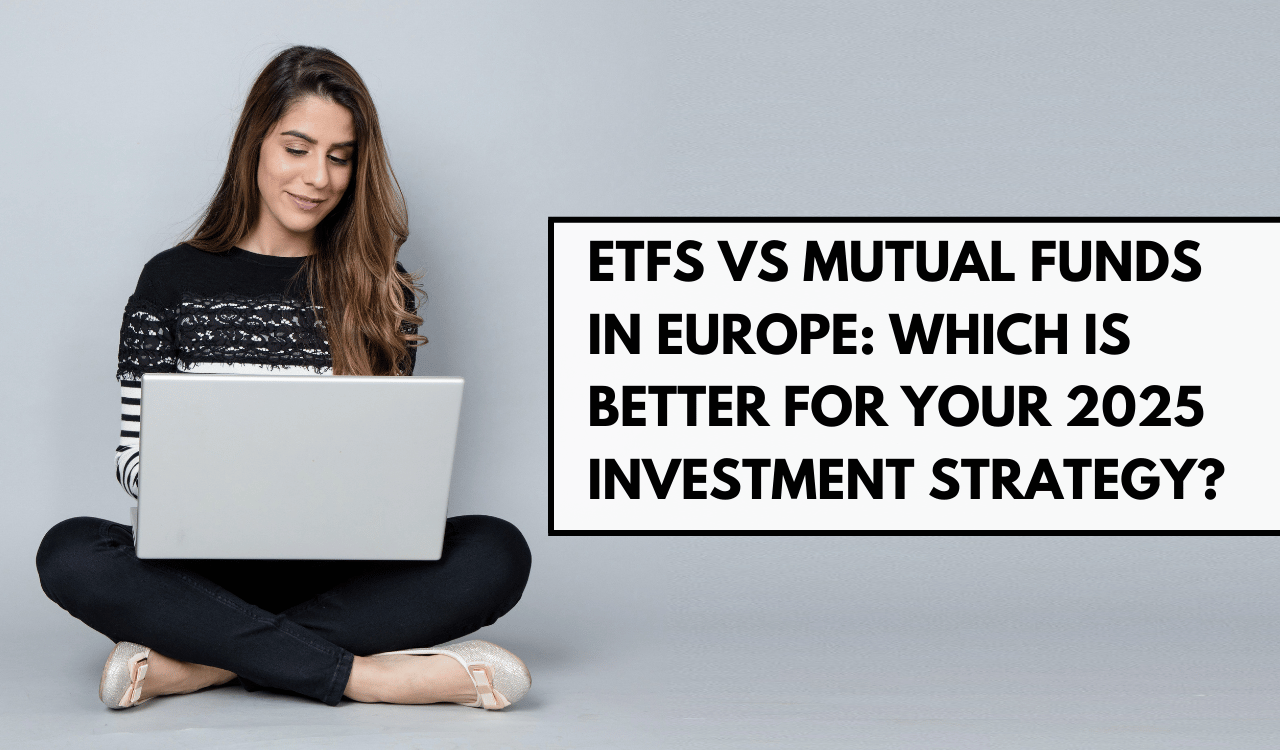Investing in Europe? One of the first big questions you’ll face is: Should you choose ETFs or mutual funds?
In 2025, European investors have more options than ever — but each vehicle has clear strengths and drawbacks. Whether you want low-cost index tracking, active fund management, or tax efficiency, understanding the differences between ETFs (Exchange-Traded Funds) and mutual funds is key to building a smarter portfolio.
In this guide, we break it all down so you can decide which investment tool is right for you.
🔍 ETFs vs Mutual Funds: Quick Comparison for European Investors
| Feature | ETFs | Mutual Funds |
|---|---|---|
| Trading | Traded throughout the day | Traded once daily at NAV |
| Management | Passive (index-tracking) | Active (managed by professionals) |
| Fees | 0.05%–0.30% TER (low) | 1.00%+ TER (higher) |
| Tax Efficiency | More tax-efficient (in-kind redemption) | May distribute capital gains |
| Liquidity | Highly liquid (exchange-traded) | Less flexible (end-of-day pricing) |
| Transparency | Daily portfolio disclosure | Less frequent disclosure |
| Best For | Passive investors, low-cost exposure | Investors seeking active management |
⚙️ Understanding How ETFs and Mutual Funds Work
🛠️ Structural Differences
- ETFs: Traded like stocks. Buy/sell any time during market hours.
- Mutual Funds: Traded only once daily at the fund’s Net Asset Value (NAV).
This means ETFs give you real-time control, while mutual funds follow a set-it-and-forget-it approach.
HDFC Bank’s analogy says it all:
- ETFs = Drone Funds (pre-programmed, auto-pilot investing)
- Mutual Funds = Combat Aircraft Funds (flexible, reactive investing)
💼 Passive vs. Active Management: Which Approach Fits You?
✅ ETFs: Track the Market
European ETFs commonly follow indices like:
- MSCI Europe
- FTSE Developed Europe
- STOXX Europe 600
- Solactive GBS Europe
These ETFs are ideal for:
- Low-cost, long-term investing
- Diversified exposure to European markets
- Hands-off investors
🔎 Mutual Funds: Try to Beat the Market
Mutual funds use professional managers to:
- Research securities
- Time market entries and exits
- Allocate capital across countries/sectors
Examples:
- TEMIX – Multi-country exposure
- FHJUX – Focus on large European firms
- MDEFX – Growth-oriented European equities
Active management might outperform passive strategies — but you’ll pay higher fees.
💸 Cost Comparison: ETFs vs Mutual Funds
ETF Expense Ratios (Europe)
- Typically 0.05% – 0.30%
- Lower costs due to passive tracking
Mutual Fund Expense Ratios
- Often 1.00% – 1.50%
- Pays for analysts, managers, and research
| Fund Name | Expense Ratio |
|---|---|
| FHJUX | 1.04% |
| MDEFX | 1.40% |
| TEMIX | 1.29% |
🧮 A 1% difference in annual costs can eat tens of thousands in returns over 20+ years!
🏛️ ETF vs Mutual Fund Tax Treatment in Europe
ETFs: Tax-Efficient by Design
- Use in-kind creation/redemption to reduce taxable events
- Fewer capital gains distributions
- Ideal for taxable brokerage accounts
Mutual Funds: Less Efficient
- Distribute gains when managers trade
- May create tax events even if you didn’t sell
🔁 In tax-deferred accounts (like pensions), the difference is less critical — but still worth considering.
🧠 ETF or Mutual Fund? Choose Based on Your Style
| Investor Type | Best Fit |
|---|---|
| DIY Passive Investor | 🟢 ETFs (low cost, easy access) |
| Believer in Manager Skill | 🟢 Mutual Funds (active strategies) |
| Day-Trader or Market Timer | 🟢 ETFs (intraday trading) |
| Hands-off Long-Term Saver | 🟢 Either, depending on fees and tax |
🌍 ETFs and Mutual Funds for European Market Exposure
🧭 Best European ETFs (2025)
| ETF | Index | Provider |
|---|---|---|
| VWCG | FTSE Developed Europe | Vanguard |
| VEUR | FTSE Developed Europe (Distributing) | Vanguard |
| IQQH | MSCI Europe | iShares |
| EUNL | MSCI World | iShares |
✅ Most are UCITS-compliant, domiciled in Ireland or Luxembourg (for tax optimization).
⭐ Top European Mutual Funds
| Fund | 3-Year Return | 5-Year Return |
|---|---|---|
| FHJUX (Fidelity Europe Fund) | 8.55% | 9.02% |
| TEMIX (Mutual European Fund) | 3.61% | 5.09% |
| MDEFX (BlackRock Eurofund) | 6.92% | 7.13% |
Many mutual funds focus on:
- Blue-chip European stocks (Nestle, Roche, ASML)
- Sector tilts (healthcare, industrials, financials)
🔄 Hybrid Strategy: Use Both ETFs and Mutual Funds
Why choose one when you can use both?
- 🟢 ETFs for core, low-cost exposure
- 🔵 Mutual funds for targeted active plays (e.g., small caps, sector bets)
💡 Example Portfolio:
- 70% ETFs (STOXX 600, MSCI Europe)
- 30% Mutual Funds (Small-cap Europe, ESG strategies)
📊 What’s New in 2025: Trends to Watch
- Active ETFs: The best of both worlds — active strategy, ETF flexibility
- ESG Investing: Huge growth in sustainable ETFs and mutual funds
- Direct Indexing: Personalized portfolios (potential ETF alternative)
- Zero-commission trading: ETFs more accessible than ever
✅ Final Verdict: ETFs vs Mutual Funds in Europe
ETFs are best for:
- Passive investing
- Intraday flexibility
- Cost-conscious investors
- Long-term wealth building
Mutual Funds are best for:
- Active management seekers
- Targeted country/sector strategies
- Investors willing to pay more for potential alpha
📌 Bottom Line: The best strategy might combine both. Use ETFs for core holdings and mutual funds for high-conviction active plays.
